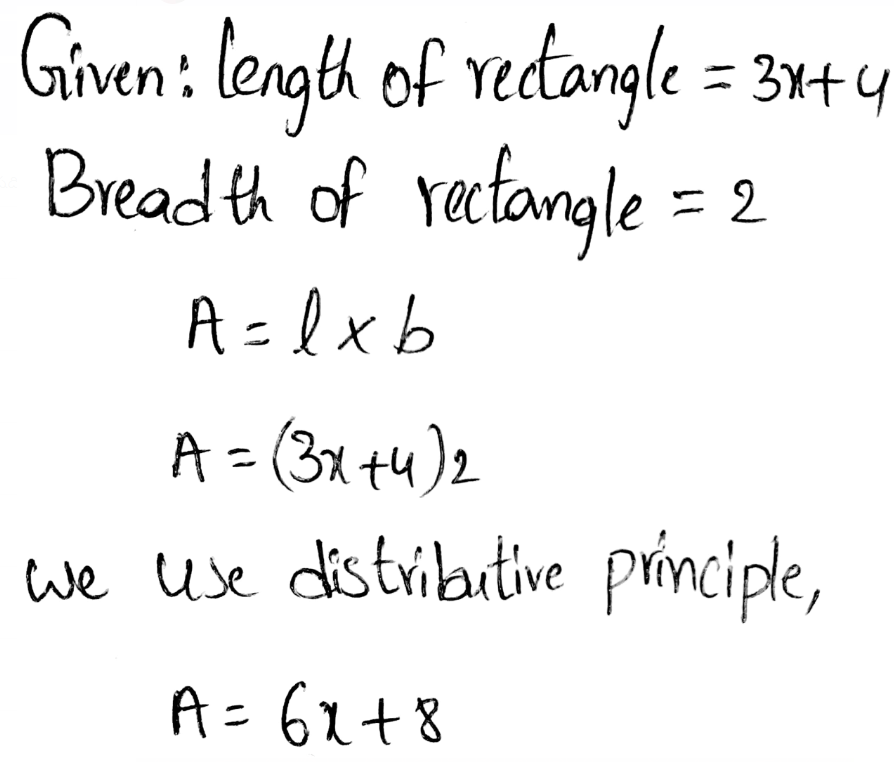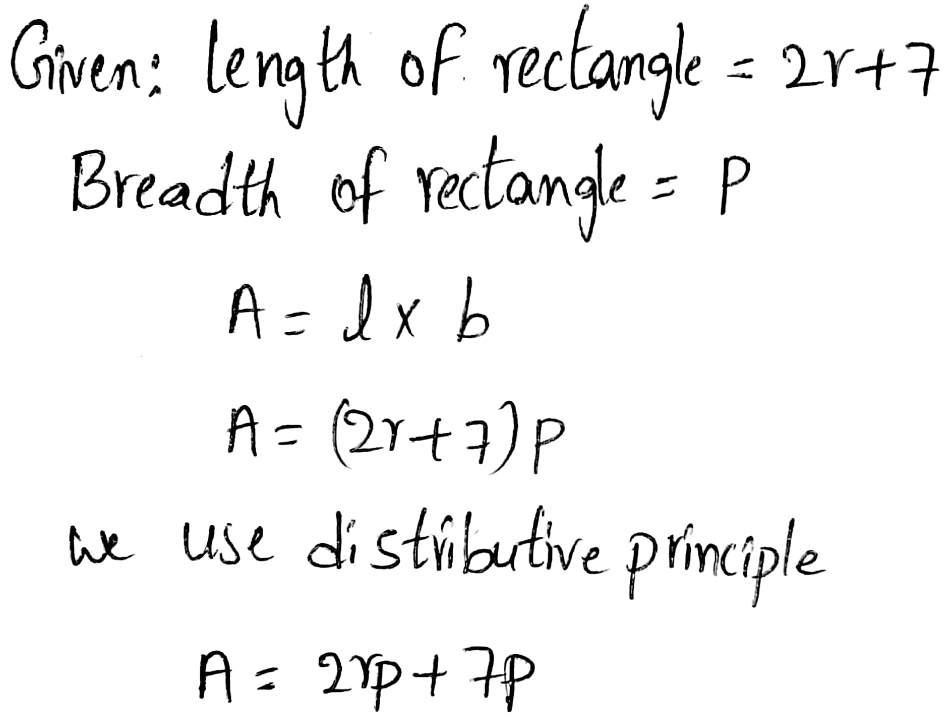Mc Graw Hill Key To Algebra Book 4 Polynomials 1st Edition Chapter 5 The Distributive Principle
Page 8 Exercise 1 Answer
Question: Solve The Polynomial 3(2x−5) By Using Distributive Principle?
Solution:
Given Polynomial: 3(2x−5)
Let us solve the equation using the distributive Principle.
⇒ 3(2x-5)
∴ 3(2x-5)=3x2x-3×5 ( Using distributive principle )
∴ 3x2x-3×5=6x-15
3(2x−5) ⇒ 6x − 15
Mcgraw Hill Distributive Principle Solutions Chapter 5 Key To Algebra
Mc Graw Hill Key To Algebra Book 4 Polynomials 1st Edition Chapter 5 The Distributive Principle Page 8 Exercise 3 Answer
Question: Solve The Polynomial 2 (3a+4b) By Using Distributive Principle?
Solution:
Given Equation:
⇒ 2 (3a+4b)
To find: Simplify using the distributive principle.
Let us solve the equation using the distributive Principle.
⇒ 2(3a+4b)
∴2 (3a+4b)=2x3a+2x4b
⇒ 6a+8b
2(3a+4b) ⇒ 6a+8b

Page 8 Exercise 5 Answer
Question: Solve The Polynomial 4(3x−y+5) By Using Distributive Principle?
Given:
⇒ 4(3x−y+5)
To find:
Simplify using the distributive principle.
Let us solve the equation using the distributive Principle.
⇒ 4(3x-y+5) (use distributive principle)
∴ (4x3x)-(4xy)+(4×5)
⇒ 12x-4y+20
Using distributive Principle.
4(3x−y+5) ⇒ 12x − 4y + 20
Page 8 Exercise 7 Answer
Question: Solve The Polynomial 6(3x−y+5) By Using Distributive Principle?
Solution:
Given:
⇒ 6(3x−y+5)
To find:
Simplify using the distributive principle
Let us solve the equation using the distributive Principle.
⇒ 6(3x-y+5) use distributive principle
∴ 6x3x-6xy+6×5
⇒ 18x-6y+30 ( Using distributive Principle)
6(3x−y+5) ⇒ 18x − 6y + 30
Chapter 5 The Distributive Principle Mcgraw Hill Algebra Key
Mc Graw Hill Key To Algebra Book 4 Polynomials 1st Edition Chapter 5 The Distributive Principle Page 8 Exercise 1 Answer
Question: Solve The Polynomial −5(2x−4) By Using Distributive Principle?
Solution:
Given:
⇒ −5(2x−4)
To find:
Simplify using the distributive principle
Let us solve the equation using the distributive Principle.
⇒ -5(2x-4) (Use distributive principle)
∴ -5(2x-4) ⇒-5x2x-(-5)x4
⇒ -5(2x-4)⇒-10x+20
−5(2x−4) ⇒ −10x + 20
Page 8 Exercise 2 Answer
Question: Solve The Polynomial −4(3y+5) By Using Distributive Principle?
Solution:
Given:
⇒ −4(3y+5)
To find: Simplify using the distributive principle
Let us solve the equation using the distributive Principle.
⇒ -4(3y+5)
∴ -4(3y+5)⇒-4x3y+(-4)x5
⇒ -4(3y+5)⇒-12y-20
−4(3y+5) ⇒ −12y − 20
Page 8 Exercise 4 Answer
Question: Solve The Polynomial (a+x)−8 By Using Distributive Principle?
Solution:
Given:
⇒ (a+x)−8
To find:
Simplify using the distributive principle
Let us solve the equation using the distributive Principle.
⇒ (a+x)-8 (use distributive principle)
∴ (a+x)-8⇒ 1xa+1×x-8
∴ (a+x)-8⇒a+x-8
(a+x)−8 ⇒ a + x − 8
How To Solve Chapter 5 The Distributive Principle Key To Algebra Book 4
Mc Graw Hill Key To Algebra Book 4 Polynomials 1st Edition Chapter 5 The Distributive Principle Page 8 Exercise 5 Answer
Question: Solve The Polynomial −4(3x2−6x+2) By Using Distributive Principle?
Solution:
Given:
⇒ −4(3x2−6x+2)
To find:
Simplify using the distributive principle
Let us solve the equation using the distributive Principle.
The given equation is:
⇒ -4(3×2-6x+2) (use distributive principle)
∴ -4(3×2-6x+2)
∴ \(-4\left(3 x^2-6 x+2\right)=-4 \times 3 x^2+4 \times 6 x-4 \times 2\)
∴\(-4\left(3 x^2-6 x+2\right)=-12 x^2+24 x-8\)
−4(3x2−6x+2) ⇒ −12x2 + 24x − 8
Page 8 Exercise 7 Answer
Question: Solve The Polynomial −1(3x2−6x+2) By Using Distributive Principle?
Solution:
Given: −1(3x2−6x+2)
To find: We have to use the distributive principle to multiply.
We can write
−1(3x2−6x+2) = −(3x2−6x+2)
Further solving using the distributive principle we get
−1(3x2−6x+2) = −3x2 + 6x − 2
Hence using the Distributive principle to solve −1(3x2−6x+2) we get −3x2 + 6x − 2.
Page 8 Exercise 8 Answer
Question: Solve The Polynomial (3x2+6x−2)(−10) By Using Distributive Principle?
Solution:
Given: (3x2+6x−2)(−10)
To find: We have to use the distributive principle to multiply.
We can write
(3x2−60x+20)(−10) = −(30x2−60x+20)
Further solving using the Distributive principle we get
(3x2−60x+20)(−10) = −30x2 + 60x − 20
Hence using Distributive principle to solve (3x2−60x+20)(−10) we get −30x2 + 60x − 20
Mc Graw Hill Key To Algebra Book 4 Polynomials 1st Edition Chapter 5 The Distributive Principle Page 8 Exercise 1 Answer
Question: Solve The Polynomial (2x−7)x By Using Distributive Principle?
Solution:
Given: (2x−7)x
To find: We have to use the distributive principle to multiply.
According to the Distributive principle, we just have to multiply the single term times each term in the polynomial
We get
(2x−7)x = 2x2 − 7x
Hence using the Distributive principle to solve(2x−7)x we get 2x2 − 7x.
Question: Solve The Polynomial (3y+5)y By Using Distributive Principle?
Solution:
Page 8 Exercise 2 Answer
Given: (3y+5)y
To find: We have to use the distributive principle to multiply.
According to Distributive principle, we just have to multiply the single term times each term in the polynomial
We get
(3y+5)y = 3y2 + 5y
Hence using Distributive principle to solve (3y+5)y we get 3y2 + 5y
Question: Solve The Polynomial 2 (3a+4b) By Using Distributive Principle?
Solution:
Page 8 Exercise 3 Answer
Given: 2 (3a+4b)
To find: We have to use the distributive principle to multiply.
According to the Distributive principle we just have to multiply the single term times each term in the polynomial
We get
x(5−8y) = 5x − 8xy
Hence using the Distributive principle to solve x(5−8y) we get 5x − 8xy.
Question: Solve The Polynomial x(2y2+3x−4) By Using Distributive Principle?
Solution:
Page 8 Exercise 6 Answer
Given: x(2y2+3x−4)
To find: We have to use distributive principle to do the multiplication.
According to Distributive principle, we just have to multiply the single term times each term in the polynomial
We get
x(2y2+3x−4) = 2xy2 + 3x2 − 4x
Hence using Distributive principle to solve x(2y2+3x−4) we get 2xy2 + 3x2 − 4x
Mcgraw Hill Algebra Book 4 Chapter 5 Explanations
Mc Graw Hill Key To Algebra Book 4 Polynomials 1st Edition Chapter 5 The Distributive Principle Page 8 Exercise 7 Answer
Question: Solve The Polynomial (2y2+3x−4)xy By Using Distributive Principle?
Solution:
Given:(2y2+3x−4)xy
To find: We have to use distributive principle to do the multiplication.
According to the Distributive principle, we just have to multiply the single term times each term in the polynomial
We get
(2y2+3x−4)xy = 2xy3 + 3x2y − 4xy
Hence using the Distributive principle to solve (2y2+3x−4)xy we get 2xy3 + 3x2y − 4xy.
Page 8 Exercise 1 Answer
Question: Solve The Polynomial 5x(4x−7)By Using Distributive Principle?
Solution:
Given: 5x(4x−7)
To find: We have to use distributive principle to do the multiplication.
According to the Distributive principle, we just have to multiply the single term times each term in the polynomial
We get
5x(4x−7) = 20x2 − 35x
Hence using Distributive principle to solve 5x(4x−7) we get 20x2 − 35x
Page 8 Exercise 2 Answer
Question: Solve The Polynomial 3a(4a+2) By Using Distributive Principle?
Solution:
Given: 3a(4a+2)
To find: We have to use distributive principle to do the multiplication.
According to the Distributive principle we just have to multiply the single term times each term in the polynomial, We get,
3a(4a+2) = 12a2 + 6a
Hence using the Distributive principle to solve 3a(4a+2) we get 12a2 + 6a.
Page 8 Exercise 3 Answer
Question: Solve The Polynomial 4x(x2−5)By Using Distributive Principle?
Solution:
Given: 4x(x2−5)
To find: We have to use distributive principle to do the multiplication.
According to the Distributive principle, we just have to multiply the single term times each term in the polynomial
We get
4x(x2−5) = 4x3 − 20x
Hence using Distributive principle to solve 4x(x2−5) we get 4x3 − 20x
Mc Graw Hill Key To Algebra Book 4 Polynomials 1st Edition Chapter 5 The Distributive Principle Page 8 Exercise 4 Answer
Question: Solve The Polynomial (2x+1)2x2 By Using Distributive Principle?
Solution:
Given: (2x+1)2x2
To find: We have to use distributive principle to do the multiplication.
According to the Distributive principle we just have to multiply the single term times each term in the polynomial
We get(2x+1)2x2 = 4x3 + 2x2
Hence using the Distributive principle to solve (2x+1)2x2 we get 4x3 + 2x2.
Page 8 Exercise 5 Answer
Question: Solve The Polynomial (3y−6)(−5y) By Using Distributive Principle?
Solution:
Given:(3y−6)(−5y)
To find: We have to use the distributive principle to multiply.
According to the Distributive principle, we just have to multiply the single term times each term in the polynomial
We get (3y−6)(−5y) = −15y2 + 30y
Hence using Distributive principle to solve (3y−6)(−5y) we get −15y2 + 30y
Page 8 Exercise 6 Answer
Question: Solve The Polynomial 7x(3x+4y) By Using Distributive Principle?
Solution:
We are given the expression 7x(3x+4y).
The objective is to use the Distributive Principle for a multiplication problem.
Given: 7x(3x+4y)
on Applying the distribution Principle, we get
7x(3x+4y)=7x.3x+7x.4y
=21x²+28xy
Hence, using the Distributive principle for the given multiplication problem 7x(3x+4y), we get the result 21x2 + 28xy.
Page 8 Exercise 7 Answer
Question: Solve The Polynomial 3a(4a−2b+c) By Using Distributive Principle?
Solution:
We are given the expression 3a(4a−2b+c).
The objective is to use the Distributive Principle for a multiplication problem.
Given: 3a(4a-2b+c)
On applying the distributive principle
3a(4a-2b+c)=3a.4a-3a.2b+3a.c
3a(4a-2b+c)=12a²-6ab+3ac
Hence, using the Distributive principle for the given multiplication problem 3a(4a−2b+c), we get the result 12a2 − 6ab + 3ac.
Page 8 Exercise 8 Answer
Question: Solve The Polynomial 5y(3x+4y−8) By Using Distributive Principle?
Solution:
We are given the expression 5y(3x+4y−8).
The objective is to use the Distributive Principle for a multiplication problem.
Given: 5y(3x+4y-8)
On applying the distributive principle, we get
5y(3x+4y-8)=5y.3x+5y.4y-5y.8
=15xy+20y²-40y
Hence, using the Distributive principle for the given multiplication problem 5y(3x+4y−8), we get the result 15xy + 20y2 − 40y.
Mcgraw Hill Key To Algebra Chapter 5 Problem Walkthrough
Mc Graw Hill Key To Algebra Book 4 Polynomials 1st Edition Chapter 5 The Distributive Principle Page 8 Exercise 9 Answer
Question: Solve The Polynomial 2xy(3x+4y−8). By Using Distributive Principle?
Solution:
We are given the expression 2xy(3x+4y−8).
The objective is to use the Distributive Principle for a multiplication problem.
Given: 2xy(3x+4y-8)
on applying the distributive principle, we get
2xy(3x+4y-8)=2xy.3x+2xy.4y-32xy.8
=6x2y+8xy2-16xy
Hence, using the Distributive principle for the given multiplication problem 2xy(3x+4y−8), we get the result 6x2y + 8xy2 − 16xy.
Page 8 Exercise 10 Answer
Question: Solve The Polynomial 7x2−5x−6)6x2 By Using Distributive Principle?
Solution:
We are given the expression 7x2−5x−6)6x2.
The objective is to use the Distributive Principle for a multiplication problem.
Hence, using the Distributive principle for the given multiplication problem (7×2−5x−6)6×2, we get the result 42x4 − 30x3 − 36x2.
Page 8 Exercise 11 Answer
Question: Solve The Polynomial −4b(a−3b+c) By Using Distributive Principle?
Solution:
We are given the expression −4b(a−3b+c).
The objective is to use the Distributive Principle for a multiplication problem.
Given: 2xy(3x+4y-8)
on applying the distributive principle, we get
2xy(3x+4y-8)=2xy.3x+2xy.4y-2xy.8
=6x²y+8xy²-16xy
Hence, using the Distributive principle for the given multiplication problem −4b(a−3b+c), we get the result −4ab + 12b2 − 4bc.
Page 8 Exercise 12 Answer
Question: Solve The Polynomial 7x2y(3x2y+2xy2+x3) By Using Distributive Principle?
Solution:
We are given the expression 7x2y(3x2y+2xy2+x3).
The objective is to use the Distributive Principle for a multiplication problem.
Given: 7x²y(3x²y+2xy²+x3)
on applying the distributive principle, we get
7x²y(3x²y+2xy²+x³)=7x²y.3x²y+7x²y.2xy²+7x²y.x³
=21x4y²+14x³y³+14x³y³+7x5y
Hence, using the Distributive principle for the given multiplication problem 7x2y(3x2y+2xy2+x3), we get the result 21x4y2 + 14x3y3 + 7x5y.
Mc Graw Hill Key To Algebra Book 4 Polynomials 1st Edition Chapter 5 The Distributive Principle Page 9 Exercise 1 Answer
Question: Solve The Equation 5(x+3) = 35. And Find The Value of x?
Solution:
We are given the equation 5(x+3) = 35.
The objective is to solve the given equation.
Given: 5(x+3)=35 on applying distributive principle, we get
5x+5.3=35
5x+15=35
5×35-15
5x=20
x= \(\frac{20}{5}\)
x=4
Hence, the solution of the given equation 5(x+3) = 35 is x = 4.
Page 9 Exercise 3 Answer
Question: Solve The Equation 2(3x+15) = 18. And Find The Value of x?
Solution:
We are given the equation 2(3x+15) = 18.
The objective is to solve the given equation.
Given: 2(3x+15)=18
on applying the distributive principle, we get
2.3x+2.15=18
6x+30=18
6x=18-30
6x=-12
\(x=\frac{-12}{6}\)
x-2
Hence, the solution of the given equation 2(3x+15) = 18 is x = −2.
Page 9 Exercise 4 Answer
Question: Find The Value Of x In The Expression 8(x−2) = 32.
Solution:
We are given the equation 8(x−2) = 32.
The objective is to solve the given equation.
Given: 8(x-2)=32
By applying the distributive principle, we get
5x+5.3=35
5x+15=35
5x=35-15
5x=20
x= \(\frac{20}{5}\)
x=4
Hence, the solution of the given equation 8(x−2) = 32 is x = 6.
Page 9 Exercise 5 Answer
Question: Find The Value Of a In The Expression 5(a+3) = 8a.?
Solution:
We are given the equation 5(a+3) = 8a.
The objective is to solve the given equation.
Let Us Assume That a= x
2(3x+15)=18 on applying distributive principle, we get
2.3x+2.15=18
6x+30=18
6x=18-30
6x=-12
x= \(\frac{-12}{6}\)
x=-2
Hence, the solution of the given equation 5(a+3) = 8a is a = 5.
Mc Graw Hill Key To Algebra Book 4 Polynomials 1st Edition Chapter 5 The Distributive Principle Page 9 Exercise 6 Answer
Question: Find The Value Of x In The Expression 7x = 4(x+6)?
Solution:
We are given the equation 7x = 4(x+6).
The objective is to solve the given equation.
Given: 7x=4(x+6)
On applying the distributive principle, we get
7x=4.x+4.6
7x=4x+24
7x-4x=24
3x=24
\(x=\frac{24}{3}\)x=8
Hence, the solution of the given equation 7x = 4(x+6) is x = 8.
Page 9 Exercise 7 Answer
Question: Find The Value Of x In The Expression 4(x+5) = 3(x−6)?
Solution:
We are given the equation 4(x+5) = 3(x−6).
The objective is to solve the given equation.
Given: 4(x+5)=3(x-6)
on applying the distributive principle, we get
4x+4.5=3.-3.6
4x+20=3x-18
4x-3x=-18-20
x=-38
Hence, the solution of the given equation 4(x+5) = 3(x−6) is x = −38.
Page 9 Exercise 8 Answer
Question: Find The Value Of x In The Expression 3(2x−5)+4 = 31?
Solution:
We are given the equation 3(2x−5)+4 = 31.
The objective is to solve the given equation.
3(2x-5)+4=31 on applying the distributive principle, we get
3.2x-3.5+4=31
6x-15=31
6x-11=31
6x=31+11
6x=42
x= \(\frac{42}{6}\)
x=7
Hence, the solution of the given equation 3(2x−5) + 4 = 31 is x = 7.
Mc Graw Hill Key To Algebra Book 4 Polynomials 1st Edition Chapter 5 The Distributive Principle Page 9 Exercise 9 Answer
Question: Find The Value Of x In The Expression 10 = 18 + 4(3x+7)?
Solution:
We are given the equation 10 = 18 + 4(3x+7).
The objective is to solve the given equation.
10=18+4(3x+7) on applying distributive principle, we get
10=18+4.3x+4.7
10=18+12x+28
10=12x+46
10-46=12x
-36=12x
x= \(\frac{-36}{12}\)
Hence, the solution of the given equation 10 = 18 + 4(3x+7) is x = −3.
Page 9 Exercise 10 Answer
Question: Find The Value Of x In The Expression 3(3x+5) = 2(6x−3)?
Solution:
Given expression is 3(3x+5) = 2(6x−3)
We find the solution for a given expression
We use the distributive principle for a given expression
Given: 3(3x+5)=2(6x-3) ( we use the distributive principle)
3.3x+3.5=2.6x-3.2
9x+15=12x-6
12x-9x=15+6
3x=21
x=\(\frac{21}{3}\)
x=7
The solution for the given polynomial is x = 7.
Page 10 Exercise 1 Answer
Question: Find The Area Of The Rectangle Whose Length = 3x and Breadth = 2x + 5?
Solution:
Given the length of the rectangle = 3x
Breadth of rectangle = 2x + 5
We find the polynomial for the area of the given rectangle
We write the formula for area of the rectangle,
A=lxb
A=3x(2x+5)
we use distributive principle
A=6x²+15x
The polynomial for the area of a given rectangle is A = 6x2 + 15x
Worked Examples For Chapter 5 The Distributive Principle Mcgraw Hill
Mc Graw Hill Key To Algebra Book 4 Polynomials 1st Edition Chapter 5 The Distributive Principle Page 10 Exercise 2 Answer
Question: Find The Area Of The Rectangle Whose Length = 3x + 4 and Breadth = 2?
Solution:
Given : Length of rectangle = 3x + 4
Breadth of rectangle = 2
We find a polynomial for the area of the given rectangle
We write the formula for the area of a rectangle,

Polynomial for area of given rectangle is A = 6x + 8
Page 10 Exercise 4 Answer
Question: Find The Area Of The Rectangle Whose Length = 2r + 7 and Breadth = p?
Solution:
Given: Length of rectangle = 2r + 7
Breadth of rectangle = p
We find the polynomial for area of given rectangle
We write formula for area of rectangle,

The polynomial for area of given rectangle is 2rp + 7p
Page 10 Exercise 6 Answer
Question: Find The Area Of The Rectangle Whose Length = 7n + 4 and Breadth = 5n?
Solution:
Given: Length of rectangle = 7n + 4
Breadth of rectangle = 5n
We find the polynomial for area of given rectangle
We write the formula for area of rectangle,
A=lxb
a=(7n+4)x(5n)
a= 35n2 + 20n (we use distributive principle)
The polynomial for area of a given rectangle is A = 35n2 + 20n
